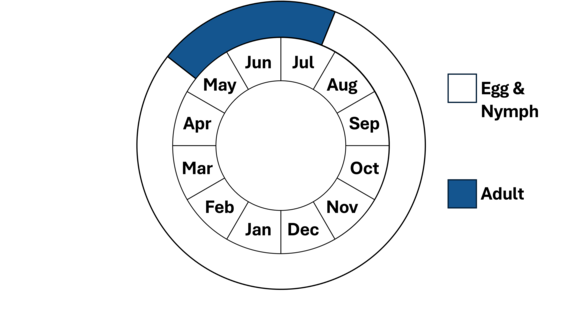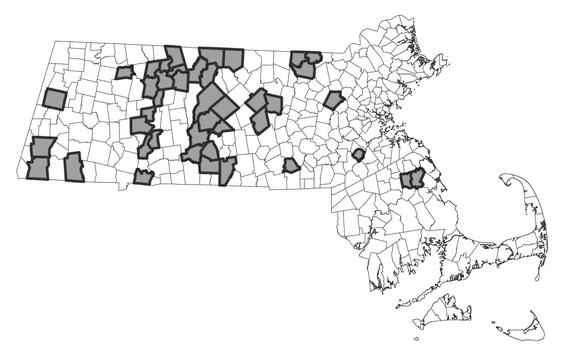- Scientific name: Hylogomphus abbreviatus
- Species of Greatest Conservation Need (MA State Wildlife Action Plan)
- Special Concern (MA Endangered Species Act)
Description
Male spine-crowned clubtail
The spine-crowned clubtail is a large, semi-aquatic insect in the order Odonata, suborder Anisoptera (the dragonflies), and family Gomphidae (the clubtails). The clubtails are a large, diverse group of dragonflies named for the lateral swelling at the tip of the abdomen that produces a club-like appearance which varies greatly among species. Clubtails are further distinguished from other dragonflies by their widely separated eyes, wing venation characteristics, and behavior. The spine-crowned clubtail is in the genus Hylogomphus (bantam clubtails), a group of small body sizes and moderately-sized clubs. Spine-crowned clubtails are dark brown/black dragonflies with pale to bright yellow markings on the body, green eyes, and black legs. The thorax (winged and legged section behind the head) is marked with thick, pale stripes dorsally and broad, pale, lateral stripes laterally. The pale thoracic markings are bright yellow in the young adults, becoming somewhat duller with age. The dark abdomen has yellow markings on top of segments one through seven (of 10 segments) and small yellow spots laterally that form an incomplete ring at the base of each segment. There are two large bright yellow patches on each side of the club. The face is dull to bright yellowish with no markings. The sexes are similar in appearance, though females have thicker abdomens and a less developed, though still prominent, club.
Adult spine-crowned clubtails range in length from 34-35 mm (1.3-1.4 in) with a wingspan averaging 66 mm (2.6 in). The fully developed nymphs average 22-25 mm (just under one inch) in length.
The spine-crowned clubtail is one of two species in the genus Hylogomphus in Massachusetts. The other species, the mustached clubtail (Hylogomphus adelphus), is very similar in appearance. The easiest way to distinguish the two species in the field is by the facial markings. The spine-crowned clubtail has a clear yellow face with no dark markings in contrast to the mustached clubtail with several black horizontal stripes marking its pale yellowish to greenish face. However, as in most clubtails, the shape of the male hamules (located on the underside of the second abdominal segment) and terminal appendages (Nikula et al. 2003), and the female vulvar lamina (located on the underside of the eighth and ninth abdominal segments) provide the most reliable means for identification.
Nymphs and exuviae can be identified using characteristics, as per the keys of Soltesz (1996), Needham et al. (2000), and Tennessen (2019).
Life cycle and behavior

Note, nymphs are present year-round.
Spine-crowned clubtails are elusive and little is known about their life history. The egg and nymph life stages are fully aquatic. The nymphs are predators, feeding on a wide variety of aquatic insects, small fish, and tadpoles. Nymphs undergo several molts (instars) for at least 2 years until they are ready to emerge as winged adults. When ready to emerge, typically in late May, the nymphs crawl out onto exposed rocks, emergent vegetation, partially submerged logs, or the steeper sections of riverbanks, where they undergo transformation to adults (a process known as eclosion). Emergence generally takes place very early in the morning, presumably to reduce exposure to predation. This species likely undergoes synchronous emergence where many individuals emerge over a short time period. The cast nymphal exoskeletons, known as exuviae, are identifiable to species and can be a reliable, useful means to determine the presence of a species.
As soon as the freshly emerged adults are dry and the wings have hardened sufficiently, they fly off to seek refuge in the vegetation of adjacent uplands. Here, they spend several days or more feeding and maturing, before returning to their breeding habitats. Spine-crowned clubtails are seldom encountered during this phase of their life; it may be that they spend most of this time high in the treetops. When mature, the males return to the water where they can be found resting on sandy stretches of shoreline or perched on overhanging vegetation or on exposed rocks. Periodically, they make flights out over the water, a foot or so above the surface, with frequent periods of hovering, presumably in search of females. Brief chases between competing males are frequent. Females generally appear at water only for a brief period when they are ready to mate and lay eggs. When a male encounters a female, he attempts to grasp the back of her head with claspers located on the end of his abdomen. If the female is receptive, she allows the male to grasp her, then curls the tip of her abdomen upward to connect with the male’s sexual organs located on the underside of the second abdominal segment, thus forming the familiar heart-shaped “wheel” typical of all Odonata, with the male above, the female upside down underneath. In this position, the pair flies off to mate, generally hidden high in nearby trees where they are less vulnerable to predators. The duration of mating in spine-crowned clubtails has not been recorded, but in similar-sized odonates typically ranges from several minutes to an hour or more. Females oviposit (lay eggs) by flying low over the water, periodically striking the surface with the tips of the abdomen to wash off the eggs. It is not known how long the eggs of spine-crowned clubtails take to develop.
Spine-crowned clubtails have a rather short flight season with emergence beginning in late May and early June and the adults flying into July.
Distribution and abundance
Spine-crowned clubtails are found only in the northeastern United States, from southwestern Maine and New Hampshire, south to North Carolina and west to Ohio. In New England, they have been recorded from southwestern Maine, southern New Hampshire, Massachusetts, Connecticut, and Rhode Island. In Massachusetts, the species occurs in the Housatonic, Farmington, Westfield, Deerfield, Middle Connecticut, Millers, Chicopee, Quinebaug, Nashua, Blackstone, Concord, Neponset, and Cape Cod watersheds. Based mostly on collected exuviae, abundances are typically low for this species but can be locally abundant. Several medium-sized streams including the sections of the Millers, Westfield, and Ware support relatively robust populations of spine-crowned clubtail. In other streams, the species have been observed at relatively low abundances and may reflect either survey effort and/or lack of suitable habitat.
The spine-crowned clubtail is listed as species of Special Concern in Massachusetts. As with all species listed in Massachusetts, individuals of the species are protected from take (picking, collecting, killing, etc.) and sale under the Massachusetts Endangered Species Act.

Distribution in Massachusetts.
1999-2024
Based on records in the Natural Heritage Database.
Habitat
Spine-crowned clubtails inhabit medium to large streams. In Massachusetts, they have been found on medium to large rivers with mud and sandy bottoms. The nymphs are aquatic and burrow into finer substrate like sand. Exuviae are typically found adjacent to depositional mesohabitats, including pools and runs. The adults inhabit riparian areas, forested uplands, fields, and when mature are often flying over swifter currents around riffles.
Healthy habitats are vital for supporting native wildlife and plants. Explore habitats and learn about conservation and restoration in Massachusetts.
Medium-sized, low gradient stream with distinct mesohabitats suitable for spine-crowned clubtail.
Threats
Degradation of water quality, alteration of streamflows, and upland habitat loss are primary threats to spine-crowned clubtail. Potential threats to the water quality include pollution and sewage overflow, salt and other road contaminant run-off, and siltation from construction or erosion. The disruption of natural flow regimes by flow regulation projects may have a negative impact on odonate populations. Extensive use of the river by power boats and jet skis that generate large wave action is a serious concern, particularly during the early summer emergence period of spine-crowned clubtails (as well as several other clubtail species). Climate change is expected to decrease suitable habitat for the species but less so than other rare lotic odonates (Collins and McIntyre 2017).
Conservation
Survey and monitoring
Recent efforts have expanded our knowledge of spine-crowned clubtail distribution and abundance largely through exuvia surveys. Since adults can be difficult to detect because of their elusive behavior, exuvia not only provides increased detection but also site-specific locations of aquatic nymph and breeding habitat. Surveys may target adults in combination with exuviae but never alone. Robust stream populations should be routinely monitored every five years or to the extent practical to document changes in occupancy and habitat conditions. Effort should also target under-surveyed streams and stream segments identified as potentially suitable habitat. It’s possible the species occurs in more eastern watersheds than currently known.
Management
Upland and stream habitat protection is critical for the conservation of spine-crowned clubtail. Protection of forested upland borders of these river systems are critical in maintaining suitable water quality and are critical for feeding, resting, and maturation. Development of these areas should be discouraged, and the preservation of remaining undeveloped uplands should be a priority. Alternatives to commonly applied road salts should tested to minimize freshwater salinization. Altered streamflows from hydroelectric operations should minimize rapid flow increase during emergence time to prevent mortalities. Hardened and channelized stream segments should be restored to promote natural sediment dynamics.
Research needs
Continued effort is needed to define habitat requirements, distribution, relative abundance, and potential breeding sites to update the species status in Massachusetts. Estimation of detection and occupancy rates and how other environmental variables (e.g., sample timing, weather) affect these rates for exuvia sampling is needed. Other research efforts include projections of species distribution under climate change scenarios and climate vulnerability analysis specifically in Massachusetts, and the potential identification of exuviae through DNA analysis as the exuviae can be difficult to distinguish with H. adelphus.
References
Brown, V.A. 2020. Dragonflies and Damselflies of Rhode Island. Rhode Island Division of Fish and Wildlife, Department of Environmental Management, West Kingston RI.
Collins S.D., and N.E. McIntyre. “Extreme loss of diversity of riverine dragonflies in the northeastern U.S. is predicted in the face of climate change.” Bulletin of American Odonatology 12,1 (2017):7-19.
Dunkle, S.W. 2000. Dragonflies through Binoculars. Oxford University Press.
Lam, E. Dragonflies of North America. Princeton NJ: Princeton University Press, 2024.
Needham, J.G., M.J. Westfall, Jr., and M.L. May. 2000. Dragonflies of North America. Scientific Publishers.
Nikula, B., J.L. Ryan, and M.R. Burne. 2007. A Field Guide to the Dragonflies and Damselflies of Massachusetts. Massachusetts Natural Heritage and Endangered Species Program.
Paulson, D. Dragonflies and Damselflies of the East. Princeton NJ: Princeton University Press, 2011.
Soltesz, K. 1996. Identification Keys to Northeastern Anisoptera Larvae. Center for Conservation and Biodiversity, University of Connecticut.
Walker, E.M. 1958. The Odonata of Canada and Alaska, Vol. II. University of Toronto Press.
Tennessen, K. Dragonfly Nymphs of North America: An identification guide. Springer, 2019.
Contact
| Date published: | April 8, 2025 |
|---|